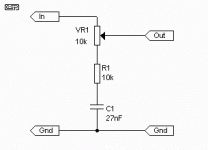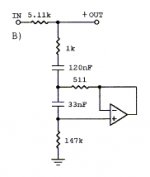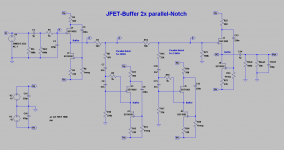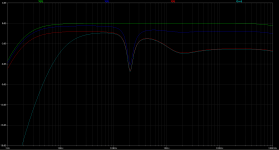I'm designing my first active filter for a simple fullrange project. I've decided to employ a variable baffle step compensator and two notch filter stages (I've attached the topologies). I understand an input buffer is needed before the first stage, but what about between stages? Is an output buffer necessary too?
Of the BSC filter, Rod Elliott says, "Opamp buffers at the input and output may be used if you cannot ensure that the source impedance is 100 ohms or less, and that the load impedance of the following stage is greater than 20k." How do I ensure that these conditions are met? If the notch follows the BSC stage, is the 5.11k resistor the load impedance?
I'm new at this, so if my questions are too trivial, please point me to some good references.
Of the BSC filter, Rod Elliott says, "Opamp buffers at the input and output may be used if you cannot ensure that the source impedance is 100 ohms or less, and that the load impedance of the following stage is greater than 20k." How do I ensure that these conditions are met? If the notch follows the BSC stage, is the 5.11k resistor the load impedance?
I'm new at this, so if my questions are too trivial, please point me to some good references.
Attachments
I understand an input buffer is needed before the first stage, but what about between stages?
Is an output buffer necessary too?.
Very good questions, and you'll need the interstage and output buffers to ensure
that the filters work properly. The input buffer may not be necessary, if your preamp
has a low source impedance.
Last edited:
In a way, you are answering yourself: if the very simple notch fikter shown above is the norm, see that it's a 5k resistor shunted to ground by a tuned circuit, in this case built around a gyrator, so:
a) input impedance is 5k, and varying resistance in series with it will change filter behavior, so yes, you need a buffer driving it.
b) output impedance is 5k interacting with the tuned circuit, any load impedance will be in parallel withthe latter, so you again need a buffer.
a) input impedance is 5k, and varying resistance in series with it will change filter behavior, so yes, you need a buffer driving it.
b) output impedance is 5k interacting with the tuned circuit, any load impedance will be in parallel withthe latter, so you again need a buffer.
Hi,
Its probably not a good idea to mix and match passive and active ideas.
Buffers keep the maths simple. There are other topologies to the two
you have chosen that may be simpler overall, not needing buffers.
(That is passive and gyrators may not be the best approach.)
Its a long time since I studied active filters, but active BSC is a doddle.
The same stage could probably do one notch, perhaps both if well separated.
Minimal active stages design is a real art, when its gets complicated.
I'd suggest downloading the Free TinaTi simulator and playing.
rgds, sreten.
Its probably not a good idea to mix and match passive and active ideas.
Buffers keep the maths simple. There are other topologies to the two
you have chosen that may be simpler overall, not needing buffers.
(That is passive and gyrators may not be the best approach.)
Its a long time since I studied active filters, but active BSC is a doddle.
The same stage could probably do one notch, perhaps both if well separated.
Minimal active stages design is a real art, when its gets complicated.
I'd suggest downloading the Free TinaTi simulator and playing.
rgds, sreten.
How do you know if your preamp has a low source impedance? Do headphone jacks on phones and soundcards have sufficiently low impedance?Very good questions, and you'll need the interstage and output buffers to ensure
that the filters work properly. The input buffer may not be necessary, if your preamp
has a low source impedance.
I'm curious to learn the topologies you mentioned--can you share any references? Six op amps for a simple fullrange filter does seem like a lot, but then again it's a first project and I'm just trying to get at something that works.There are other topologies to the two you have chosen that may be simpler overall, not needing buffers. (That is passive and gyrators may not be the best approach.)
The same stage could probably do one notch, perhaps both if well separated.
Thanks for the replies.
How do you know if your preamp has a low source impedance? Do headphone jacks on phones
and soundcards have sufficiently low impedance?
The preamp's specs should state its output impedance. In this case, under 1k ohms should be low enough.
Most headphone jacks and cards should also be ok. Passive circuits, or tube preamps, may have
higher output impedance and be less compatible.
Last edited:
I'm curious to learn the topologies you mentioned--can you share any
references? Six op amps for a simple fullrange filter does seem like a lot,
but then again it's a first project and I'm just trying to get at something
that works.
Thanks for the replies.
Hi,
Its a long time since I studied active filters and I don't remember much.
Nevertheless nothing I studied looked at combining functions in stages.
I worked out myself that is was possible for certain cases later on.
Whatever I'm sure you can do what you want with two opamps per channel.
One does the BSC and the higher notch, the other other the lower notch.
As a clue you can implement unity gain Sallen Key filters using the
opamps negative input as a unity gain point rather than the opamps
output for opamps (or amplifiers) with gain.
rgds, sreten.
rgds, sreten.
Hi,
You can combine the two Noch filters within a pair of buffers.
I´m using such structures for many years without any probs.
I like to design the filters without textbook formulas in my mind but rather like one would design passive crossover filters .... combining filter and equalizer functionality at the same, thereby reducing the number count of filter building blocks and parts.
Especially the number of active devices directly related to the signal path are reduced (only J1 and J7 in this case, all else are positioned in ´shunt-positions´).
The example utilizes discrete JFET-Buffers which I prefer over OPAmps simply because those filters sound much more authentic and true to my ears (and others too I might add) 😉
If the feeding source impedance and the following load impedance are not clearly defined I´d suggest to always use a Input (J1/J2) and an Output (J7/J8) Buffer as shown.
The two Buffers may be filters by themselves, for example unity-gain-Sallen-Key HPs or LPs.
This way even quite complex filtering can be achieved with a minimum of active parts in the immediate signal path.
jauu
Calvin
You can combine the two Noch filters within a pair of buffers.
I´m using such structures for many years without any probs.
I like to design the filters without textbook formulas in my mind but rather like one would design passive crossover filters .... combining filter and equalizer functionality at the same, thereby reducing the number count of filter building blocks and parts.
Especially the number of active devices directly related to the signal path are reduced (only J1 and J7 in this case, all else are positioned in ´shunt-positions´).
The example utilizes discrete JFET-Buffers which I prefer over OPAmps simply because those filters sound much more authentic and true to my ears (and others too I might add) 😉
If the feeding source impedance and the following load impedance are not clearly defined I´d suggest to always use a Input (J1/J2) and an Output (J7/J8) Buffer as shown.
The two Buffers may be filters by themselves, for example unity-gain-Sallen-Key HPs or LPs.
This way even quite complex filtering can be achieved with a minimum of active parts in the immediate signal path.
jauu
Calvin
Attachments
- Status
- Not open for further replies.
- Home
- Source & Line
- Analog Line Level
- Active filter for fullrange: where do you need op amp buffers?



